Class 11-science H C VERMA Solutions Physics Chapter 16 - Sound Waves
Sound Waves Exercise 273
Solution 1
Time gap = tair - tsteel
= d/vair - d/vsteel
=1/330 - 1/5200
= 2.75 × 10-3 sec
Δt = 2.75 ms
Solution 2
Distance travelled by sound to come back = 80×2 = 160 m
Time interval = distance/speed
= 160/320
= 0.5 sec
Solution 3
Time gap between two claps = 3/10 =0.3 sec
Distance travelled by sound between two claps = 50+50
= 100 m
Velocity = distance/time
= 100/0.3
V≈333 m/s
Solution 4
v = fxλ
For λmax = v/fmin
=360/20
=18m
For λmin = v/fmax
=360/20×103
λmin = 18 mm
Solution 5
V=f × λ
For λ max = V/fmin
=1450/20
λ max = 72.5 m
For λ min = V/fmax
=1450/20000
λ min = 7.25 cm
Solution 6
(a)λsound = 10.dspeaker
=10(20)
=200 cm=2m
V=f ×λ
f=340/2 = 170 Hz
(b) λsound = d/10
=20/10
=2cm
=0.02 m
V= f ×λ
F=340/0.02
=17000 Hz
Solution 7
V=f×λ
In air
λ =v/f
λ air = 340/4.5×106
λ air=7.6×10-5m
In tissue
λ =v/f
λ issue = 1.5×103/4.5×106
λ t = 3.3×10-4m
Solution 8
y=6sin(600t-1.8×)
Comparing equation with y=Asin (wt±Kx)
K=1.8; w=600; A=6×10-5m
2![]() / λ =1.8
/ λ =1.8
λ=2![]() /1.8
/1.8
(a)
A/λ = 6×10-5/(2![]() /1.8)=1.7×10-5
/1.8)=1.7×10-5
(b)
Wave speed = (coefficient of t)/(coefficient of x)
Vw=600/1.8 = 100/3 m/s
Velocity Amplitude = A![]()
=(6×10-5)(600)
Vp=36×10-3m/sec
Ratio=Vp/Vw=36×10-3/(100/3) = 1.1×10-4
Solution 9
V=f×λ
350=100×λ
λ=3.5m
(a)
△Ø=![]() .t
.t
=(2![]() f)t
f)t
=(2![]() )(100)(2.5×10-3)
)(100)(2.5×10-3)
=![]() /2
/2
(b)
△ Ø=![]() . △×
. △×
=![]() .x(0.1)
.x(0.1)
=2![]() /35
/35
Solution 10.(a)
(a)Path difference of two waves = 30-20
△=10 cm
Ø = ![]() .△
.△
=![]() ×10
×10
Ø =4![]()
Since Ø =2n![]() i.e., constructive interference
i.e., constructive interference
So phase difference is zero
(b) Path difference = 0
So, Ø=0
Solution 11
Density= mass/volume
![]() =
=![]()
Adiabetic Constant = Cp/Cv
![]() =3.5R/2.5R
=3.5R/2.5R
v=![]()
=![]() =310m/s
=310m/s
Solution 12
v![]()
V1/V2=![]()
340/V2=![]()
V2=349m/s
Solution 13
V![]()
V12/V22=T1/T2
v12/(2v1)2=(0+273)/T2 [∵v2=2v1]
T2=273×4K
T2=273×4-273
T2=819°C
Solution 14
The variation of temperature at a distance x from surface of T1 temperature
T= ![]() .x+T1
.x+T1
Velocity of
sound V![]()
![]() =
=![]()
VT=![]() =v
=v![]()
![]() =
=![]() x V
x V
![]() =
=![]()
t = ![]()
Putting T1=280K, T2=310K,d=33m and v=330m/s
t= 96 ms
Solution 15
v=![]()
![]() =v2
=v2![]()
![]() = v2
= v2![]()
△V=![]()
= ![]()
△V=0.14 cm3
Solution 16
P=βAK
β=![]()
β=![]() /△
/△
β=1.4×105N/m2
Solution 17
(a) I=P/A=P/4![]() r2
r2
I=![]()
I=44 mW/m2
(b) I=(pressure
amp.)2/2![]()
Pmax=![]()
=![]()
Pmax=6 N/M2
(c) I=2![]() 2f2A2
2f2A2![]() v
v
A=![]()
A=1.2*![]() m
m
Solution 18
I![]()
I1/I2=r22/r12
10-8/I2=(25)2/(5)2
I2=4×10-10w/m2
Solution 19
△L=10log![]()
=10log![]()
=10log(5/50)2
40-L=-20dB
L=20dB
Solution 20
△L=10log![]()
=10log![]()
△L=3dB
Solution 21
I=P/A=P/4![]() r2
r2
r=![]()
= ![]() [∵ when
L=120dB then I=1w/m2]
[∵ when
L=120dB then I=1w/m2]
r=0.4m=40cm
Solution 22
△L=10log![]()
(60-50)=10log![]()
![]() =10
=10
I![]() ρ2
ρ2
![]() =√10
=√10
Solution 23
△L=10log![]()
Let I be the intensity produced by each student
△L=10log![]()
L-50=10×0.3
L=53dB
Solution 24
Path difference between consecutive maxima
and minima=![]() /2
/2
If tube is slided by x, then
2×=![]() /2
/2
![]() =2×(2.5*10-2)*2
=2×(2.5*10-2)*2
![]() =10-1m
=10-1m
V=f*![]()
f=340/10-1
f=3.4kHz
Solution 25
(a)
Path difference
between consecutive maxima and minima=![]() /2
/2
If tube is slided by x
2x=![]() /2
/2
![]() =4×16.5×10-3
=4×16.5×10-3
![]() =66×10-3m
=66×10-3m
V=f*![]()
330=f×66×10-3
f=5kHz
(b)
Imax/Imin=(A1+A2)2/(A1-A2)2
9I/I=(A1+A2)2/(A1-A2)2
A1/A2=2
Solution 26
Path difference of the sound waves = 6.4-6
△=0.4m
For destructive interference
△=![]()
0.4=![]()
f= ![]() × (2n+1)
× (2n+1)
f=400(2n+1)
Putting n=1,2,3… till f˂5000Hz
So, frequencies are 1200 Hz, 2000Hz, 2800Hz, 3600Hz and 4400Hz
Solution 27
If board is moved by x then extra path difference between waves is 2x.
Path difference between consecutive maxima and minima is λ/2
So, λ/2=2x
λ =4×20×10-2
λ =0.8m
v=f× λ
f=336/0.8
f=420Hz
Solution 28
Initially, path difference is =2[![]() ]- d
]- d
△i=2d
Let cardboard is shifted by distance x, then
final path difference = 2[![]() ]- d
]- d
Path difference between consecutive maxima
and minima is λ/2 = ![]()
∆net=∆f-∆i
d/4 = 2[![]() -d ]- 2d
-d ]- 2d
On solving
X=0.13d
Solution 29
Path difference = ![]() - 3.2
- 3.2
△=0.8m
For destructive interference,
△=![]() = 0.8
= 0.8
(2n+1)(320/f) = 2×0.8
f=200(2n+1)
Lowest frequency heard when n=0 will be f=200Hz
For Highest frequency f=20,000Hz=200(2n+1)
N=49.5
So maximum value of n is 49
On putting n=0,1,2,…..49 person will hear in audible range.
Solution 30
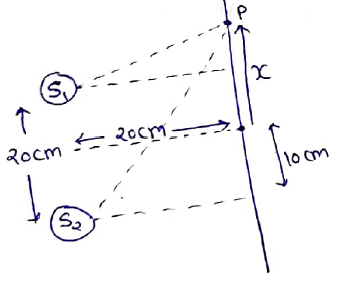
Let detector is moved by x at point P
Path difference between consecutive maxima and minima is λ/2 = 20/2 = 10cm
△=S2P - S1P
10=![]() -
-![]()
On solving,
X=12.6cm
Solution 31
V=fxλ
λ=330/600 = 11/20 m
(a)
D-1 will be observed here
△=dsinθ
λ/2 = dsinθ
½ x 11/20 = 2sinθ
sinƟ = 11/8
Ɵ=11/80 rad. [∵ angle is small sin≈Ɵ]
Ɵ=11/80×180°/π=7.9°
(b)
B-1 will be formed
△=dsinƟ
λ =dsinƟ
11/20 = 2sinƟ
sinƟ=11/40
Ɵ=11/40x180°/π=16°
(c)
Let nth be last maxima obtained at θ=90°
△=dsinƟ
nλ=dsin90°
N(11/20) = 2
n=3.63
So, last maxima is for n=3.
So, he get two maxima from point P along the line as he walks.
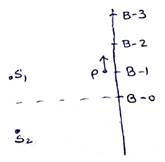
Solution 32
∵ I![]() A2
A2
∵A1=A2=A3=A
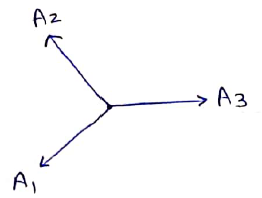
By vector method,
Resultant Amplitude =0
So,
IN=0
Solution 33
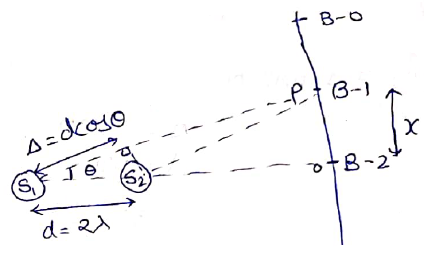
At point O,
△=S1O-S2O
△=2λ(constructive interference B-2 order)
So,
At point P, B-1 will be formed
△=dcosƟ
1×λ=2λcosƟ
Ɵ=60°
In △S1PO
tan60°=x/D
X=√3D
Solution 34
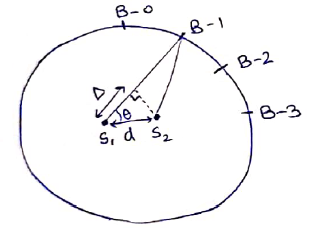
∆=dcos Ɵ
Ɵ =cos-1(△/3 λ)
B-0; △=0 => Ɵ=90°
B-1; △=λ => Ɵ =70.5°
B-2; △=2 λ => Ɵ =48.2°
B-3; △=3 λ => Ɵ =0°
Solution 35
Let intensity of each source be I
(a)
At P
∆=S2P-S1P=0
So, Ø=0 (constructive interference)
Imax=(√I1+√I2)2 = (√I+√I)2
Io=4I
Now, when one source is switched off intensity at this point will be I i.e., Io/4
(b)
If Ɵ=60° then also △=0
So, no change in answer
Solution 36
Fundamental frequency of O.O.P =V/2l
=340/2(0.2)
=850Hz
Ist overtone frequency =2f
f1=2(850)
f1=1700Hz
IInd overtone frequency = 3f
f2=3(850)
f2=2550Hz
Solution 37
Fundamental frequency of C.O.P.=V/4l
500=(340)/4l
l=0.17m=17cm
Solution 38
Distance between consecutive nodes = λ/2 = 4cm
V=f×λ
328=f×8/100
f=4.1KHz
Solution 39
Distance between consecutive node and antinode is λ/4
λ/4=25cm
λ=1m
v=fxλ
f=340Hz
Solution 40
Frequency in O.O.P.
f=nv/2l
f=n(340)/2(0.5)
f=n(340)
So, frequencies between 1000Hz and 2000Hz will be when n=3,4,5 i.e. f=1020,1360,1700Hz respectively.
Solution 41
L2-L1= λ /2
62-20= λ /2
λ =84cm=0.84m
(a)
V=fx λ
V=400(0.84)
V=336m/s
(b)
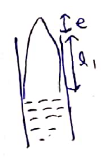
L1+e= λ /4
20+e=84/4
e=1cm
Solution 42
Ist overtone frequency of cop=fundamental frequency of oop
3×v/4lc = v/2lo
3/(4×30) = 1/2×lo
Lo=20cm
Solution 43
For fundamental frequency
λ/2=1
λ=2m
v=f×λ
3800=f×2
f=1.9kHz
Other frequency are given by = n×1.9KHz
where n=1,2,…. 10 in range of 20Hz-20,000Hz
Solution 44
f=v/2l
Lmax=v/2fmin
Lmax=340/(2)(20) = 8.5m
Solution 45
(a)
Fundamental frequency of o.o.p = v/2l
=340/2(0.05)
f=3.4KHz
(b)
Let nth harmonic be highest in audible range
f'=nf
20,000=n(3400)
n=5.8
So,n=5
Solution 46
Fundamental frequency f cop=![]() =
= ![]() =100Hz
=100Hz
Higher harmonics frequencies = (2n+1)100
Where n=0,1,…….. 9
Solution 47
Difference between two successive resonance
frequency in O.O.P. = ![]() -
- ![]() =
= ![]()
(2592-1944) = ![]()
l=0.25m
l=25cm
Solution 48
Path difference between two consecutive maxima = λ=2×32 cm
λ=0.64m
v=f×λ
=512(0.64)
v=328m/s
Solution 49
Fundamental frequency in shorter arm for
cop=![]()
440=![]()
![]() =18.8cm
=18.8cm
In longer arm, Ist
overtone frequency = ![]()
440=![]()
![]() =0.563m or
=0.563m or ![]() =56.3cm
=56.3cm
Solution 50
IInd harmonic of wire = fundament frequency of cop
![]() =
= ![]()
![]() =
= ![]()
[∵![]() =mass/length]
=mass/length]
T=11.6N
Solution 51
Fundamental frequency of wire = fundamental frequency of cop
![]() =
= ![]()
![]() =
= ![]()
T=347N
Solution 52
f![]()
![]()
f![]()
![]()
by error
![]() =
= ![]()
Solution 53
f![]()
![]()


![]() =294Hz
=294Hz
Solution 54
![]() Rod/4 = 25cm=
100cm=1m
Rod/4 = 25cm=
100cm=1m
λair/2 = 5cm =10cm=0.1m
vair/λair=vrod/λred
340/0.1 = vrod/1
vrod=3400m/s
Solution 55
Lrod=λr/2
λr =2m
λgas/2=6.5cm
λgas=13cm
f=vair/λa=vrod/λr
2600=vair/13×10-2=vrod/2
Vair=338m/s and vrod=5200m/s
Solution 56
Frequency of source is 476Hz or 480Hz
Number of beats is 2
So, possible frequency of tuning fork=476±2 or 480 ±2
=474,478 or 478,482
So, common frequency of tuning fork=478Hz
Solution 57
Frequency of tuning fork 'A'=256Hz
No. of beats=4
So, frequency of tuning fork 'B'=256±4
'B'=252Hz or 260Hz
Now, on waxing fork 'B', its frequency will decrease and will produce and beats with A which is possible when frequency of fork B is 252 Hz
Solution 58
Beat frequency = f2-f1
=v/λ2-v/λ1
=![]() -
-![]()
≈7Hz
Solution 59
Fundamental frequency of cop=v/4l
=(320)/[(4)(0.4)]
=200Hz
Tuning fork produces 5 beats with cop
ffork=205 or 195Hz
When loaded with wax, frequency will decrease.
∵Beat frequency decreases
ffork=205Hz
Solution 60
Initially,
FA=fB=600Hz
∵f![]() √T
√T
As tension increases, frequency increases
So, fA=606Hz; fB=600Hz
fA/fB=√TA/√TB
606/600 = √TA/√TB
TA/TB=1.02
Solution 61
Frequency of wire=256±4
=252Hz or 260Hz
fwire=![]() = fwire
= fwire![]()
By shortening, the length of wire, fwire increases.
∵Beat frequency decreases
So, fwire = 252Hz
Initially, fwire=252Hz and length of wire = 25cm
Later, fwire=256Hz and length of wire = lf
fi/ff=lf/li
252/256 = lf/25
lf=24.6cm
Length shortened = 25-24.6
=0.6cm
Solution 62

Vo=10m/s
fo=2000Hz
fapp= fo
[![]() ]= 2000 [
]= 2000 [![]() ]
]
fapp=2.06KHz
Solution 63

vs=18×![]() = 5m/s
= 5m/s
fo=2400Hz
fapp=fo[![]() ]
]
2400[![]() ]
]
fapp=2436Hz
Solution 64
(a)

Vs=20m/s
fo=1250Hz
fapp= fo[![]() ]
]
=1250[![]() ]
]
=1328Hz
(b)

fo=1250Hz
fapp= fo[![]() ]
]
=1250[![]() ]
]
fapp=1181Hz
Solution 65
Initially,

fapp=fo[![]() ]=1620 ---(1)
]=1620 ---(1)

Fapp=fo[[![]() ]----(2)
]----(2)
Divide(1) and(2),
1620/Fapp=v+vs/v-vs
1620/Fapp=340+15/340-15
Fapp=1480Hz
Solution 66
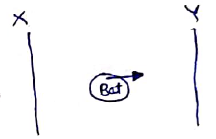
Apparent frequency received by wall Y is
f' = fo[![]() ]
]
Apparent frequency received by bat after reflection from the wall Y is
f'' = f'[![]() ]
]
=4.5×104![]()
f''=4.66×104Hz
Apparent frequency received by wall x is
n'=fo[![]() ]
]
Apparent frequency received by bat after reflection from the wall x is
n''=n'[![]() ]
]
=4.5×104![]()
n''=4.33×104Hz
Beat frequency = 4.66×104-4.33×104
=3300Hz
Solution 67
Apparent frequency heard before bullet crosses person
f1=fo[![]() ]
]
=fo[![]() ]
]
=3 fo
Apparent frequency heard after bullet crosses person
f2=fo[![]() ]
]
=fo[![]() ]
]
F2=0.6fo
So, f2/f1=0.6fo /3fo=0.2
∴Fractional change = 1-0.2
=0.8
Solution 68
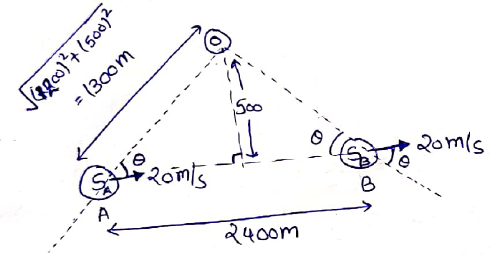
Velocity of train = 72kmph
=72×![]()
=20m/s
Frequency heard by person from train A=fo[![]() ]
]
=500[![]() ]
]
=529Hz
Frequency
heard by person from train B = fo[![]() ]
]
=500[![]() ]
]
=474Hz
Solution 69
(a)
Beat frequency for standing man = 4
So, apparent frequency heard by standing man = 440± 4
=444Hz or 430Hz
Since, source is coming towards observer so fapp=444Hz
fapp=[![]() ]fo
]fo
444=[![]() ].440
].440
Vs=3.09m/s
=3.09×![]() =11kmph
=11kmph
(b)
The sitting man will listen to fewer than 4 beats/sec
Solution 70
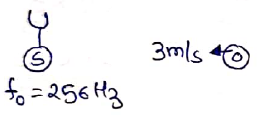
f1=fo[![]() ]
]
=256[![]() ]
]
=258.3Hz

f2=fo[![]() ]
]
=256[![]() ]
]
f2=253.7Hz
Beat frequency = f1- f2
=4.6Hz
Solution 71

f1=fo[![]() ]
]
=512[![]() ]
]
=520.6Hz

f2=fo[![]() ]
]
F2=512[![]() ]=503.6Hz
]=503.6Hz
∴ Beats = f1-f2
=17.5Hz
Solution 72
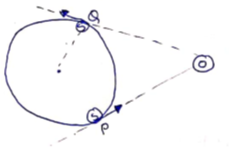
Velocity of source = Rw =![]() =10m/s
=10m/s
Maximum and Minimum frequency will be observed at point PandQ respectively
fapp
/max=fo[![]() ]
]
=500[![]() ]=515.5Hz
]=515.5Hz
fapp/min=fo[![]() ]
]
=500[![]() ]=485Hz
]=485Hz
Solution 73

vs=90×![]() =25m/s vo=25m/s
=25m/s vo=25m/s
Fo=500Hz
Apparent frequency = fo[v+vo/v-vs]
=500[350+25/350-25]
=577Hz
Solution 74

fo=16Hz
fapp=20KHz
fapp=fo[![]() ]
]
20×103=16× 103× [![]() ]
]
Vo=330/4 m/s
=330/4×18/5=297Kmph
This speed is not practically attainable for ordinary cars
Solution 75

fo=800Hz
fapp=fo[(v-vo)/(v-vs)]
fapp=800[(330-20)/(330-30)]≈827Hz
Solution 76

(a)
Frequency received by second submarine
Fapp=fo[(v+vo)/(v-vs)]
=2000[(1500+15)/(1500-10)]=2034hz
(b)frequency heard by first submarine
F'app=2034[(1500+10)/(1500-15)]
=2068Hz
Solution 77
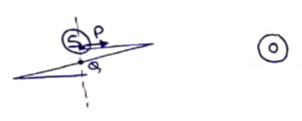
Maximum and minimum frequency will be observed at mean position P and Q respectively as velocity of source will be maximum
fmax=fo[![]() ; fmin=fo[
; fmin=fo[![]()
fmax- fmin=8
fo[![]() - fo[
- fo[![]() = 8
= 8
2fovvs/v2-vs2=8
![]()
Vs=1.7m/s
Aw=1.7
W=![]() =10
=10
T=2![]() /w=2
/w=2![]() /10
/10
T=0.63sec
Solution 78
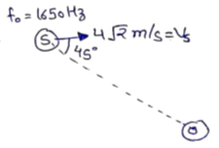
fo=1650Hz
fapp=fo [![]()
=1650[![]()
fapp=1670Hz
Solution 79
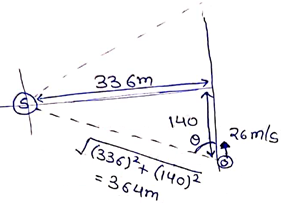
(a)
fapp=fo[![]()
=660[![]()
=680Hz
(b)
No. relative velocity along line joining source and observer
So, no. Doppler effect fapp=660Hz
(c)
fapp=fo[![]()
=660[![]()
=640Hz
Solution 80
(a)
No relative motion between passenger and train Hence fobs=500Hz
(b)

fo=500Hz
fapp=fo[![]()
=500[![]() = 459Hz
= 459Hz
(c)
When wind starts blowing,
Frequency heard by passenger is unaffected as no relative motion,
Frequency heard by person standing near track
Fapp=fo[ ![]() ]
]
=500[![]() ]
]
=458Hz
Solution 81

(a)
Frequency received by wall
fapp=fo[
![]() ]
]
=1600[![]() ]
]
=1616Hz
(b)
Reflected
frequency received by boy = f[![]() ]
]
=1616[![]() ]
]
=1632Hz
Solution 82
Frequency received by car
Fapp=f°[![]() ]
]
=1600[![]() ]
]
=1503Hz
Reflected frequency received by boy
f'app=fapp[![]() ]
]
=1503[![]() ]
]
=1417Hz
Solution 83
Velocity of car = 54×![]() = 15m/s
= 15m/s
(a)
Net velocity of wave in front of the car = vair-vcar=335-15=320m/s
V=f×λ
320=400×λ
Λ=0.8m or λ=80cm
(b)
Frequency received by the diff
fdiff=fo[![]() ]
]
=400[![]() ]
]
=418.75Hz
V=fxλ
335=418.75×λ
λ=80cm
(c)
Frequency of the reflected sound wave heard by the person sitting in the car
fapp=fcliff[![]() ]
]
=418.75(![]() )
)
fapp=437Hz
(d)
Beat frequency =437-400
=37
But a human-being can hear maximum of 10 beats in one second
So, he will not hear beats but continuous sound.
Solution 84
Frequency of sound heard at car
f=fo[![]() ]
]
f=400[![]() ]
]
Frequency of the reflected sound by observer
f'=f[![]() ]
]
410=400[![]() ][
][![]() ]
]
Vcar=4m/s
Solution 85
(a)
Speed=distance/time
330=330/t
t=1sec
(b)
Frequency of sound heard by listener = 2khz
Since, no velocity is along line joining source and observer hence, no Doppler effect
(c)
For source
Vs=d/t
d=22×1
d=22m away from P on x-axis
Solution 86
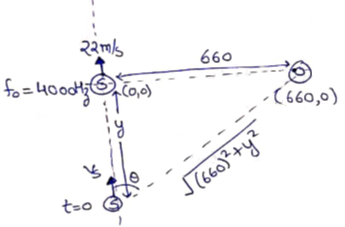
At t=0, let the source be at a distance of y from origin. Now, time taken by source to reach origin is same as time taken by sound to reach observer
y/22=![]()
6=660/√224
Frequency heard by the observer
fapp=fo[ ![]() ]
]
=4000[![]() ]
]
fapp≈4018Hz
Solution 87
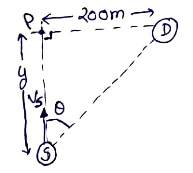
(a)
Time taken by source to reach intersection point is equal to the time taken by sound to reach detector
y/170 =![]()
y=200/√3
Frequency of sound heard by detector
fapp=fo[![]() ]
]
=1200[
![]()
=1600Hz
(b)
Detector will detect frequency of 1200Hz when sound was produced at intersection point.
Time to by sound to reach detector
T=200/340
In this time source moves by a distance of
V=d/t
D=170×![]() = 100m
= 100m
So, source-detector.distance
= ![]()
=224m
Solution 88

(a)
Maximum frequency observed when maximum velocity of source is towards observer
fapp)A=fo[![]() ]
]
=500[![]() ]
]
fapp)A≈514Hz
(b)
fapp)D=fo[![]() ]
]
=500[![]() ]
]
=490Hz
Fapp)B=fo[![]() ]
]
=500[![]() ]
]
=511Hz
Solution 89
Let the distance between the source and observer is x at t=0
Time taken for 1st pulse to reach observer t1=x/v
IInd pulse starts after T(where T=1/f)
and it travels a distance of (![]() )
)
So, t2=T+![]()
Now, t2-t1=(![]() -
-![]() )-(
)-(![]() )
)
t2-t1=T-![]()
Putting T=1/f
t2-t1=(2fv-a)/(2fv2)
Beat frequency = 1/t2-t1=2fv2/2fv-a

